[English] 日本語
 Yorodumi
Yorodumi- PDB-8wbg: CryoEM structure of non-structural protein 1 tetramer from ZIKA virus -
+ Open data
Open data
- Basic information
Basic information
| Entry | Database: PDB / ID: 8wbg | ||||||
|---|---|---|---|---|---|---|---|
| Title | CryoEM structure of non-structural protein 1 tetramer from ZIKA virus | ||||||
 Components Components | Genome polyprotein | ||||||
 Keywords Keywords |  VIRAL PROTEIN / VIRAL PROTEIN /  flavivirus / non-structural protein 1 flavivirus / non-structural protein 1 | ||||||
| Function / homology |  Function and homology information Function and homology informationsymbiont-mediated suppression of host JAK-STAT cascade via inhibition of STAT2 activity / ribonucleoside triphosphate phosphatase activity /  double-stranded RNA binding / double-stranded RNA binding /  viral capsid / viral capsid /  mRNA (nucleoside-2'-O-)-methyltransferase activity / mRNA 5'-cap (guanine-N7-)-methyltransferase activity / mRNA (nucleoside-2'-O-)-methyltransferase activity / mRNA 5'-cap (guanine-N7-)-methyltransferase activity /  RNA helicase activity / host cell endoplasmic reticulum membrane / RNA helicase activity / host cell endoplasmic reticulum membrane /  protein dimerization activity / symbiont-mediated suppression of host type I interferon-mediated signaling pathway ...symbiont-mediated suppression of host JAK-STAT cascade via inhibition of STAT2 activity / ribonucleoside triphosphate phosphatase activity / protein dimerization activity / symbiont-mediated suppression of host type I interferon-mediated signaling pathway ...symbiont-mediated suppression of host JAK-STAT cascade via inhibition of STAT2 activity / ribonucleoside triphosphate phosphatase activity /  double-stranded RNA binding / double-stranded RNA binding /  viral capsid / viral capsid /  mRNA (nucleoside-2'-O-)-methyltransferase activity / mRNA 5'-cap (guanine-N7-)-methyltransferase activity / mRNA (nucleoside-2'-O-)-methyltransferase activity / mRNA 5'-cap (guanine-N7-)-methyltransferase activity /  RNA helicase activity / host cell endoplasmic reticulum membrane / RNA helicase activity / host cell endoplasmic reticulum membrane /  protein dimerization activity / symbiont-mediated suppression of host type I interferon-mediated signaling pathway / symbiont entry into host cell / viral RNA genome replication / protein dimerization activity / symbiont-mediated suppression of host type I interferon-mediated signaling pathway / symbiont entry into host cell / viral RNA genome replication /  RNA-dependent RNA polymerase activity / serine-type endopeptidase activity / fusion of virus membrane with host endosome membrane / host cell nucleus / virion attachment to host cell / virion membrane / structural molecule activity / RNA-dependent RNA polymerase activity / serine-type endopeptidase activity / fusion of virus membrane with host endosome membrane / host cell nucleus / virion attachment to host cell / virion membrane / structural molecule activity /  proteolysis / extracellular region / proteolysis / extracellular region /  ATP binding / ATP binding /  membrane / membrane /  metal ion binding metal ion bindingSimilarity search - Function | ||||||
| Biological species |   dengue virus type 4 dengue virus type 4 | ||||||
| Method |  ELECTRON MICROSCOPY / ELECTRON MICROSCOPY /  single particle reconstruction / single particle reconstruction /  cryo EM / Resolution: 3.2 Å cryo EM / Resolution: 3.2 Å | ||||||
 Authors Authors | Jiao, H.Z. / Pan, Q. / Hu, H.L. | ||||||
| Funding support | 1items
| ||||||
 Citation Citation |  Journal: Sci Adv / Year: 2024 Journal: Sci Adv / Year: 2024Title: The step-by-step assembly mechanism of secreted flavivirus NS1 tetramer and hexamer captured at atomic resolution. Authors: Qi Pan / Haizhan Jiao / Wanqin Zhang / Qiang Chen / Geshu Zhang / Jianhai Yu / Wei Zhao / Hongli Hu /  Abstract: Flaviviruses encode a conserved, membrane-associated nonstructural protein 1 (NS1) with replication and immune evasion functions. The current knowledge of secreted NS1 (sNS1) oligomers is based on ...Flaviviruses encode a conserved, membrane-associated nonstructural protein 1 (NS1) with replication and immune evasion functions. The current knowledge of secreted NS1 (sNS1) oligomers is based on several low-resolution structures, thus hindering the development of drugs and vaccines against flaviviruses. Here, we revealed that recombinant sNS1 from flaviviruses exists in a dynamic equilibrium of dimer-tetramer-hexamer states. Two DENV4 hexameric NS1 structures and several tetrameric NS1 structures from multiple flaviviruses were solved at atomic resolution by cryo-EM. The stacking of the tetrameric NS1 and hexameric NS1 is facilitated by the hydrophobic β-roll and connector domains. Additionally, a triacylglycerol molecule located within the central cavity may play a role in stabilizing the hexamer. Based on differentiated interactions between the dimeric NS1, two distinct hexamer models (head-to-head and side-to-side hexamer) and the step-by-step assembly mechanisms of NS1 dimer into hexamer were proposed. We believe that our study sheds light on the understanding of the NS1 oligomerization and contributes to NS1-based therapies. | ||||||
| History |
|
- Structure visualization
Structure visualization
| Structure viewer | Molecule:  Molmil Molmil Jmol/JSmol Jmol/JSmol |
|---|
- Downloads & links
Downloads & links
- Download
Download
| PDBx/mmCIF format |  8wbg.cif.gz 8wbg.cif.gz | 273.6 KB | Display |  PDBx/mmCIF format PDBx/mmCIF format |
|---|---|---|---|---|
| PDB format |  pdb8wbg.ent.gz pdb8wbg.ent.gz | 221.1 KB | Display |  PDB format PDB format |
| PDBx/mmJSON format |  8wbg.json.gz 8wbg.json.gz | Tree view |  PDBx/mmJSON format PDBx/mmJSON format | |
| Others |  Other downloads Other downloads |
-Validation report
| Arichive directory |  https://data.pdbj.org/pub/pdb/validation_reports/wb/8wbg https://data.pdbj.org/pub/pdb/validation_reports/wb/8wbg ftp://data.pdbj.org/pub/pdb/validation_reports/wb/8wbg ftp://data.pdbj.org/pub/pdb/validation_reports/wb/8wbg | HTTPS FTP |
|---|
-Related structure data
| Related structure data |  37424MC 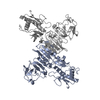 8wbbC 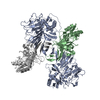 8wbcC 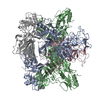 8wbdC 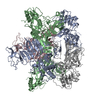 8wbeC 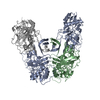 8wbfC 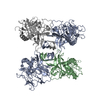 8wbhC M: map data used to model this data C: citing same article ( |
|---|---|
| Similar structure data | Similarity search - Function & homology  F&H Search F&H Search |
- Links
Links
- Assembly
Assembly
| Deposited unit | 
|
|---|---|
| 1 |
|
- Components
Components
| #1: Protein | Mass: 44498.160 Da / Num. of mol.: 4 Source method: isolated from a genetically manipulated source Source: (gene. exp.)   dengue virus type 4 / Production host: dengue virus type 4 / Production host:   Spodoptera frugiperda (fall armyworm) / References: UniProt: A0A1V0E2B5 Spodoptera frugiperda (fall armyworm) / References: UniProt: A0A1V0E2B5 |
|---|
-Experimental details
-Experiment
| Experiment | Method:  ELECTRON MICROSCOPY ELECTRON MICROSCOPY |
|---|---|
| EM experiment | Aggregation state: PARTICLE / 3D reconstruction method:  single particle reconstruction single particle reconstruction |
- Sample preparation
Sample preparation
| Component | Name: ZIKA virus non-structural protein 1 tetramer / Type: COMPLEX / Entity ID: all / Source: RECOMBINANT |
|---|---|
| Source (natural) | Organism:   dengue virus type 4 dengue virus type 4 |
| Source (recombinant) | Organism:   Homo sapiens (human) Homo sapiens (human) |
| Buffer solution | pH: 7.5 |
| Specimen | Embedding applied: NO / Shadowing applied: NO / Staining applied : NO / Vitrification applied : NO / Vitrification applied : YES : YES |
Vitrification | Cryogen name: ETHANE / Humidity: 100 % |
- Electron microscopy imaging
Electron microscopy imaging
| Experimental equipment |  Model: Titan Krios / Image courtesy: FEI Company |
|---|---|
| Microscopy | Model: FEI TITAN KRIOS |
| Electron gun | Electron source : :  FIELD EMISSION GUN / Accelerating voltage: 300 kV / Illumination mode: FLOOD BEAM FIELD EMISSION GUN / Accelerating voltage: 300 kV / Illumination mode: FLOOD BEAM |
| Electron lens | Mode: BRIGHT FIELD Bright-field microscopy / Nominal magnification: 105000 X / Nominal defocus max: 1800 nm / Nominal defocus min: 1200 nm / Cs Bright-field microscopy / Nominal magnification: 105000 X / Nominal defocus max: 1800 nm / Nominal defocus min: 1200 nm / Cs : 2.7 mm / C2 aperture diameter: 100 µm : 2.7 mm / C2 aperture diameter: 100 µm |
| Image recording | Electron dose: 54 e/Å2 / Film or detector model: GATAN K3 BIOQUANTUM (6k x 4k) |
- Processing
Processing
CTF correction | Type: PHASE FLIPPING AND AMPLITUDE CORRECTION |
|---|---|
3D reconstruction | Resolution: 3.2 Å / Resolution method: FSC 0.143 CUT-OFF / Num. of particles: 127526 / Symmetry type: POINT |
 Movie
Movie Controller
Controller








 PDBj
PDBj

